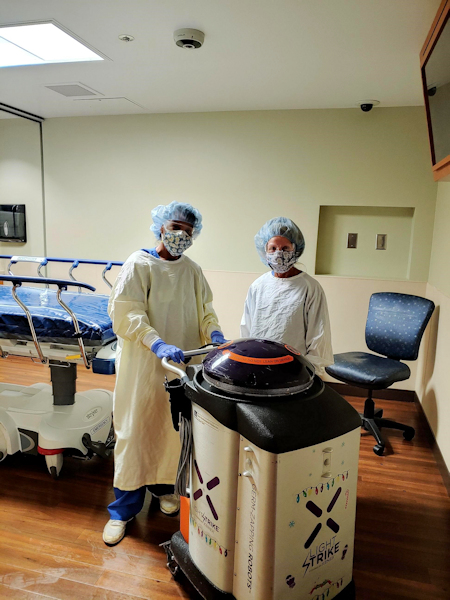When you think of robots, you’re likely to picture the cyborg from the “The Terminator” movie franchise or the ever-helpful Rosie from the beloved cartoon “The Jetsons.”
At Tanner, two real-life germ-zapping robots — aptly named Rosie and The Germinator — help the health system ensure patients’ safety by killing germs in patient care environments and common areas.
 In use since 2017, the LightStrike™ Germ-Zapping™ Robots by Xenex — medical-grade UV light cleaning machines — give patients and visitors an added layer of comfort at the health system’s flagship hospital.
In use since 2017, the LightStrike™ Germ-Zapping™ Robots by Xenex — medical-grade UV light cleaning machines — give patients and visitors an added layer of comfort at the health system’s flagship hospital.
Despite their amusing names, the robots have proven extremely efficient at eliminating viruses and dozens of other harmful germs that may remain on surfaces in patient environments even after manual cleaning is done.
“The UV light can reach places our disinfectant can’t,” said Missie Robertson, RN, vice president of institutional performance at Tanner. “We clean and sanitize these spaces, but then we bring in the robot to kill any germs we couldn’t reach. The light is so intense that no one can be around it while it’s running. These are very powerful devices, and we’re lucky as a hospital to have them.”
Tanner has three Xenex robots. Two are dedicated to decontaminating care areas — including operating suites and patient rooms — and one is reserved for sanitizing N95 masks.
And the technology that the robots use is leading-edge.
Certain levels of UV rays — such as those from the sun or a tanning bed — are powerful enough to damage human skin — but the germicidal UV rays emitted from the Xenex robots are intense enough to break down harmful germs like COVID-19 and irradiate it at the cellular level.
“The light disrupts the nucleus of the cell and decimates any organism that might be resistant to typical cleaning on surfaces,” said Robertson.
Xenex’s robots use a broad-spectrum UV light, unlike anything consumers may purchase from a retail store.
Sanitizing with UV light is especially effective in areas where hospitals are caring for patients in high-risk populations, such as those with certain types of infections like staph, influenza and C. difficile.
For three years, Tanner has routinely used its Xenex robots in its hospitals as an additional layer of protection when disinfecting patient rooms, waiting areas and other heavy-traffic and high-contact areas and surfaces.
In the age of COVID-19, the light-powered robots will prove even more important as the high-powered ultraviolet (UV) light can kill that virus as well.
“This gives patients and visitors the added assurance that they’re safe while they’re in our hospital,” said Robertson. “Protecting people from disease is what we do — and these robots are another vital tool in our toolbox.”
The robots are also helping to protect staff and help the health system prolong the use of its personal protective equipment (PPE).
One approach that many healthcare facilities have implemented is using high-powered UV light to sanitize and extend the use of certain PPE, including N95 masks.
Studies from the Centers for Disease Control and Prevention (CDC) provide guidance on how to use UV light to extend the use of N95s during the COVID-19 pandemic. Tanner employed its technology in a whole new way, with research from Xenex, medical studies and additional guidance issued from the CDC showing how broad-spectrum UV light could be used to irradiate viruses from N95 protective face covers.
“We have been searching all the resources that are available to us and found that the CDC and some of the academic centers that have been at the center of this storm have developed strategies and standards to help us extend the availability and use of our PPE,” said Robertson. “There are facilities that weren’t able to wear their PPE through the surge of COVID-19 patients because they did not preserve it. Using the robot has allowed us to ensure our professionals have the equipment they need to stay safe while caring for patients.
The only PPE Tanner is sanitizing with UV light are N95s, which can withstand the UV rays without being degraded. Tanner collects masks from certain areas where staff may go through several a day — including units treating COVID-19 patients.
Danielle Green, environmental services administrative manager for Tanner, explained that once a nurse takes off one of their N95s, they bag it to be collected by the environmental services team, who brings the mask to a designated room at Tanner Medical Center/Carrollton to be sanitized.
“According to the guidance, the masks are hung at a specified height and distance away from the robot and are thoroughly sanitized, tagged, bagged and redistributed to their original owners — so they receive clean masks to wear every day,” Green said.
With the health system reopening surgical and diagnostic procedures, Robertson emphasized that Tanner’s top priority is safety.
“People who come into our facilities should feel safe,” she said. “These robots are another level of protection for our patients and visitors.”
More information about the organization’s COVID-19 response is available at tanner.org/ncov.